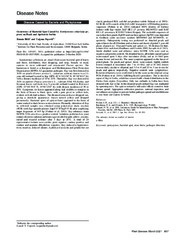Приказ основних података о документу
Occurrence of Bacterial Spot Caused by Xanthomonas arboricola pv. pruni on Peach and Apricot in Serbia
| dc.creator | Iličić, Renata | |
| dc.creator | Popović Milovanović, Tatjana | |
| dc.date.accessioned | 2023-07-12T09:54:10Z | |
| dc.date.available | 2023-07-12T09:54:10Z | |
| dc.date.issued | 2021 | |
| dc.identifier.issn | 0191-2917 | |
| dc.identifier.issn | 1943-7692 | |
| dc.identifier.uri | https://plantarum.izbis.bg.ac.rs/handle/123456789/655 | |
| dc.description.abstract | Xanthomonas arboricola pv. pruni (Xap) causes bacterial spot of leaves and fruits, defoliation, fruit dropping, and twig, branch, or trunk cankers in most cultivated and ornamental Prunus species. The bacterium is listed as a European and Mediterranean Plant Protection Organization (EPPO) A2 quarantine pathogen. Xap was first detected in 2019 on peach (Prunus persica L., unknown cultivar) leaves in a 13-year-old orchard located in Irig (GPS: 45°6′10.538″ N, 19°54′8.04″ E), with a disease incidence of 10 to 20%. Thereafter, Xap was detected in 2020 on apricot (Prunus armeniaca L., cultivars NS4, NS Rodna, and Roxana) leaves and fruits in a 5-year-old orchard located in Bešenovo (GPS: 45°04′59.0″ N, 19°41′23.0″ E), with disease incidence of 30 to 50%. Symptoms on leaves appeared along leaf midribs or margins in the form of brown to black spots, with a pale green to yellow halo, evident on both leaf surfaces. The diseased area on leaves dropped out, giving a shot-hole appearance; leaves turned yellow and dropped prematurely. Bacterial spots of apricot fruits appeared in the form of water-soaked or dark brown sunken lesions. Primarily, detection of Xap in collected samples was obtained using polymerase chain reaction (PCR) with Xap-specific primers XapY17-F/XapY17-R, after amplifying target fragments of 943 bp (Pothier et al. 2011). Xap reference strain NCPPB 3156 served as a positive control. Isolations performed on yeast extract–dextrose–calcium carbonate agar resulted in pale yellow, circular, raised and mucoid colonies after 3 days at 26°C. A total of 20 representative isolates were aerobic, gram negative, catalase positive, and oxidase and arginine dihydrolase negative; they induced a hypersensitivity reaction, reduced nitrates, hydrolyzed aesculin and gelatin but not starch, produced H2S, and did not produce indole (Schaad et al. 2001). NCBI BLASTn search of the ftsX (ABC transporter ATP-binding protein) sequences (Pothier et al. 2011) indicated 100% identity of Serbian isolates with Xap strains XAP HU2 (P. persica, MG049921) and XAP HU1 (P. armeniaca, KY039173) from Hungary. The nucleotide sequences of one isolate from peach (Xp219) and one from apricot (Xp320) were deposited in GenBank under accession numbers MT890969 and MT890970, respectively. Pathogenicity testing was performed on detached peach and apricot leaves for all 20 isolates and on leaves and shoots of potted 1-year-old plants of peach (cv. Vineyard Peach) and apricot (cv. NS Rodna) for three isolates from each host (Randhawa and Civerolo 1985; Suesada et al. 2013). Sterile distilled water and reference strain NCPPB 3156 were used as negative and positive controls. On detached leaves, all isolates caused typical water-soaked spots 3 days after inoculation (DAI), and at 10 DAI spots became brown and necrotic. The same symptoms appeared on the leaves of potted plants. On peach and apricot shoots water-soaked, slightly reddish lesions emerged at inoculation sites 7 to 10 DAI, and at 20 DAI lesions become dark, circular to elliptical, and 3.5 to 4 and 2.5 to 3 cm in size for peach and apricot, respectively. Negative controls were symptomless. Reisolated bacteria were confirmed to be the same as the original using PCR (Pothier et al. 2011), fulfilling Koch’s postulates. This is the first report of Xap in Serbia, which has occurred with a limited distribution in the Fruška Gora region (Vojvodina). Only two orchards in Serbia have been detected with Xap so far. In the diseased peach orchard Xap was eradicated by uprooting trees. The apricot orchard is still under official control to limit disease spread. Appropriate cultivation practices, national inspection, and surveillance are in place to prevent further pathogen spread and establishment to new hosts and regions in Serbia. | sr |
| dc.language.iso | en | sr |
| dc.publisher | American Phytopathological Society | sr |
| dc.rights | openAccess | sr |
| dc.rights.uri | https://creativecommons.org/licenses/by-nc-nd/4.0/ | |
| dc.source | Plant Disease | sr |
| dc.subject | prokaryotes | sr |
| dc.subject | bacterial spot | sr |
| dc.subject | stone fruits | sr |
| dc.subject | pathogen detection | sr |
| dc.title | Occurrence of Bacterial Spot Caused by Xanthomonas arboricola pv. pruni on Peach and Apricot in Serbia | sr |
| dc.type | article | sr |
| dc.rights.license | BY-NC-ND | sr |
| dc.citation.issue | 3 | |
| dc.citation.rank | M21 | |
| dc.citation.spage | 697 | |
| dc.citation.volume | 105 | |
| dc.type.version | publishedVersion | sr |
| dc.identifier.doi | 10.1094/PDIS-08-20-1817-PDN | |
| dc.identifier.fulltext | http://plantarum.izbis.bg.ac.rs/bitstream/id/2707/bitstream_2707.pdf | |
| dc.identifier.scopus | 2-s2.0-85103501215 | |
| dc.identifier.wos | 000663983700027 |


